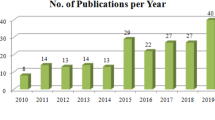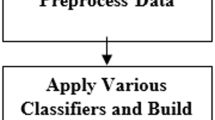Abstract
Technology and data analysis have evolved into a resource-rich tool for collecting, researching and comparing student achievement levels in the classroom. There are sufficient resources to discover student success through data analysis by routinely collecting extensive data on student behaviour and curriculum structure. Educational Data Mining (EDM), a method of data analysis in the learning environment, has emerged as an emerging trend in the development of educational data mining and analysis techniques. EDM aids in the comprehension of student behaviour as well as the factors that influence student behaviour and achievement. Student learning patterns, student culture, and instructional skills are all important factors in a successful study of EDM students. This study will look at how technology and data mining are used in the EDM environment and compare the results. We have used previous research to determine which method is best for observing the learning environment and what factors influence student academic performance. Two state-of-the-art models i.e. decision tree (classifier) and DBSCAN (clustering method) are used to predict the performance of an educational institute with higher accuracy.











Similar content being viewed by others
Explore related subjects
Discover the latest articles, news and stories from top researchers in related subjects.References
Altadmri, A., & Brown, N. C. C. (2015) 37 Million compilations: investigating novice programming mistakes in large-scale student data (pp. 522–527)
Berland, M., Baker, R. S., & Blikstein, P. (2014). Educational Data Mining and Learning Analytics: Applications to Constructionist Research, (pp. 205–220). https://doi.org/10.1007/s10758-014-9223-7
Blackboard (n.d.) (2017). Higher Education Technology. Available at: https://www.blackboard.com/industries/higher-education. Accessed 15 July 2021
Bogarín, A., Romero, C., Cerezo, R., & Sánchez-santillán, M. (2014) Clustering for improving Educational Process Mining (pp. 11–15)
Brown, N. C. C., Kölling, M., Mccall, D., & Utting, I. (2014). Blackbox: A large scale repository of novice programmers activity (pp. 223–228)
Ceglar, A., & Roddick, J. F. (2006). Association Mining, 38(2). https://doi.org/10.1145/1132956/1132958
Delavari, N., Phon-amnuaisuk, S., Reza, M., Data, B., Application, M., Delavari, N., & Phon-amnuaisuk, S. (2011). Data mining application in higher learning institutions to cite this version: HAL Id: hal-00588765 Data mining application in higher learning institutions (1)
Edwards, S. H. (2017). (n. d.) No Title, The Web-CAT Community. Available at: https://web-cat.org/. Accessed 15 June 2021
Flynn, P. J. (2000). Data clustering: a review. 31(3)
Frank, E., Hall, M. A., & Witten, I. H. (2017). The WEKA workbench. Data Mining (pp. 553–571). https://doi.org/10.1016/b978-0-12-804291-5.00024-6
ICP (2016). No Title. Available at: https://icp.edu.pk/. Accessed April 2021
Ihantola, P., Edwards, S. H., Petersen, A., Sheard, J., Korhonen, A., Spacco, J., Butler, M., Rivers, K., Szabo, C., & Toll, D. (2016). Educational data mining and learning analytics in programming: literature review and case studies (pp. 41–63)
Islamia College Peshawar (2017). No Title. Available at: https://icp.edu.pk/page.php?abc=201412160325244
Learning, M., Publishers, K. A., Sciences, A. C., & August, R. (2007). Induction of decision trees (pp. 81–106)
Maheswari, K., & Priya, P. P. A. (2018). Predicting customer behavior in online shopping using SVM classifier. Proceedings of the 2017 IEEE International Conference on Intelligent Techniques in Control, Optimization and Signal Processing, INCOS 2017 (pp. 1–5). https://doi.org/10.1109/ITCOSP.2017.8303085
Marques, V. M. (2013). Comparison of Data Mining techniques and tools for data classification (pp. 113–116)
Member, S. (2010). Educational data mining: a review of the state of the art. 40(6), 601–618
Romero, C., & Ventura, S. (2010). Educational data mining: A review of the state of the art. IEEE Transactions on Systems, Man and Cybernetics Part C: Applications and Reviews, 40(6), 601–618. https://doi.org/10.1109/TSMCC.2010.2053532
Sanchez-santillan, M. (2016). 'Predicting Students’ Performance: Incremental Interaction Classifiers (pp. 217–220)
Singley, M. K., & Lam, R. B. (2005). The Classroom Sentinel: Supporting Data-Driven Decision-Making in the Classroom (pp. 315–321)
University of Peshawar 2018. Available at: www.uop.edu.pk
Witten, I. H., Frank, E., & Hall, M. A. (2016). Data Mining: Practical Machine Learning Tools and Techniques. Third Edit. Morgan Kaufmann
Zhang, M., Hao, D., Zhu, J., Liu, C., Zou, Y., & Yan, H. (2015). Educational Evaluation in the PKU SPOC Course. Data Structures and Algorithms (pp. 2013–2016)
Author information
Authors and Affiliations
Corresponding author
Ethics declarations
All co-authors have seen and agree with the contents of the manuscript and there is no financial interest to report.
Conflict of interest
The authors have no conflicts of interest to declare.
Additional information
Publisher’s Note
Springer Nature remains neutral with regard to jurisdictional claims in published maps and institutional affiliations.
Rights and permissions
About this article
Cite this article
Shoaib, M., Sayed, N., Amara, N. et al. Prediction of an educational institute learning environment using machine learning and data mining. Educ Inf Technol 27, 9099–9123 (2022). https://doi.org/10.1007/s10639-022-10970-4
Received:
Accepted:
Published:
Issue Date:
DOI: https://doi.org/10.1007/s10639-022-10970-4




